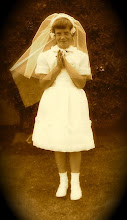Owning an antiques and art store.... I come across many books that are just too worn out. I love to choose books that already have a natural age discoloration. There's something just so organic and soulful about using these ancient pages as a substrate for today's work. In the two examples I'll post, you will see the 1890's dictionary pages, and also Sear's catalog pages (a 1970's reprint).
For my work surface I like to use a large piece of heavily waxed paper. The runoff glue is easier to wipe off. I use a 50/50 mixture of Methyl Cellulose http://www.dickblick.com/zz127/36/ and PVA for the glue. I make a large batch (8 oz. at a time) of this and keep it in the fridge. I use a wide, 3" brush to evenly apply the glue.
I simply glue one page on top of the next, alternating the direction of the pages. The grain is usually up and down, so the next sheet is glued sideways, and so on. Depending on the size of the pages, I'll fold over the surplus paper, building an even density.
Once each sheet is glued to the next, I run an bone folder across both directions... the surplus glue seeps out and I wipe it off. After a while I learned to get just the right amount on with little seepage. For the altered bag book pages, I used 6-8 book pages. This gives just enough strength. Also, seems to be a good strength for ATCs. For thicker, even sturdier, more bookboard like pages, just keep adding them on.
To prevent warping, bending, rippling....
THE MOST IMPORTANT.... not to be overlooked step, is the drying and pressing time. Each page is placed on top of several layers of newsprint paper, and another two or so sheets on top of that. Then a large board that extends to the edges of your pages. On top of that, a heavy weight, the heavier the better. The newsprint will wick out the dampness and will need to be changed several times. I'll switch out the damp for fresh paper about once an hour, maybe three times... then let the finished pages sit overnight. This will make them really nice and stiff and smooth.
I imagine you could do the pressing/wicking process between adding/gluing sheets, but I tend to be impatient. For me, it's kinda like quilting or weaving.... bringing together materials to make something new and wonderful!
It's really easy! Here's a pic of the 1890's dictionary pages as a finished project in an altered album:
Notice how the natural aging looks. I love it!
On the left below, you can see where I have folded the surplus paper back on itself, resulting in and interesting effect. Amazing, using dictionary pages, there are always some word/s that apply to the composition!
Here are tags I made from the Sear's catalog. (These I inked to give the aged look to the edges. (FYI... the ribbons on these tags are actual lingerie ribbon from an ancient spool! so cool!)
And these I cut down to ATC size. Fun stuff!
So, that in a nutshell is how I make "bookboard". I'd love to get feedback from you, about this process, or how you make yours.




4 comments:
Great layouts - you have good composition and they're very artful too! I'm glad you got your blog up and are bravely sharing your lovely art with us!
And welcome to Trends , too :)
Chris, Thanks for the tutorial. I sell antiques and used books too. So, I really appreciate this. I'll put Methl Cellulose on the Blick want list!
Thanks,
Kathy Christian
kathleenachristian@yahoo.com
These look terrific and this project is definitely on my list of things to try!
I SOO want to come to your house to play!!!! Your so amazing!!! I feel blessed to know you! I want to make some book board,it is a dream of mine to own a botique/art/antiques shop!!! Your so LUCKY I LOVE antiques!! Any ideas what i can do with antiques hankies?? I'd love to hear your ideas!!
Hugs,
Dawn
Post a Comment